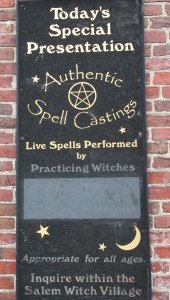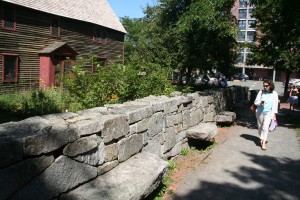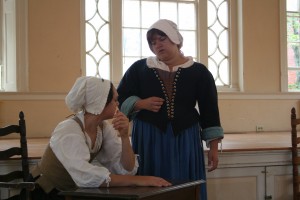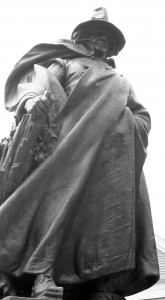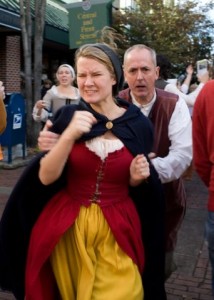
Today’s post is my monthly column for the Episcopal News Service (which will be familiar to those of you who read my posts on Salem last month):
The witches are gathering in Salem, Massachusetts, this month — along with wizards and warlocks and a host of elaborately costumed revelers, who flock to this seaside town every October for one of the nation’s largest Halloween celebrations.
There’s no small amount of irony in this, of course, for Salem became infamous because of its fear of witches. In 1692 a group of young girls accused their neighbors of witchcraft, creating an atmosphere of hysteria that eventually resulted in the deaths of 20 innocent people. The tragedy took place at a time when Salem was a vulnerable, struggling community trying to survive under harsh conditions. Tensions over property disputes, grazing rights, and church privileges fueled the paranoia of those who thought the devil was at work in Salem.
Contrast that atmosphere with the Salem of today, a town that has the silhouette of a flying witch on the side of its police cars and a statue of the TV witch Samantha in its downtown. And yet the ghosts of the witch trials are not completely laid to rest here in this picturesque city, for Salem doesn’t shrink from telling the world about that dark chapter of its history. In museums, monuments, and theatrical performances, a tragic story unfolds.
I must admit that as a Christian, visiting Salem was disconcerting at times. The intolerance, ignorance, bigotry, bullying, and sheer awfulness of what happened in Salem have been a black mark on Christianity for three centuries.
At the same time, what happened at Salem is a microcosm of what has happened again and again in human history–the scapegoating of the innocent, the abuse of the vulnerable, the hysteria of a mob. It’s appropriate that Elie Wiesel, Holocaust survivor and Nobel Peace Prize recipient, led the campaign to establish a monument to the victims of the Salem witch trials, for he recognized the similarities between what had happened to the Jews of Europe and the accused witches of Salem.
To me, the most evocative part of my trip to Salem was a performance of Cry Innocent, a play based on the pre-trial examination of accused witch Elizabeth Bishop. Audience members sit in an actual courtroom as actors in period attire move around the room taking on the roles of judge, accusers, neighbors, and victim. It’s an effective technique, making it seem as if one is right in the middle of a witch trial.
The performance gave me sympathy for the confusion that must have gripped Salem during that time. By the standards of the day, Elizabeth Bishop seemed guilty. Why couldn’t she recite the Lord’s Prayer without stumbling? That might indeed be a sign she was in league with the devil. Why did she scratch the face of her neighbor’s child? Before long I could see how a web could be woven of half-truths, wild accusations, and jealousy.
As I walked out of the courtroom, I wondered what it would be like to be put on trial by my neighbors. I can see the overwhelming temptations of such a setting, how old grievances could be aired and scores settled. Especially in the precarious world of seventeenth-century Salem, it must have been a great relief to find an answer to the mysteries of failed crops, stillborn babies, and deaths by sudden illness. Then, as now, scapegoats represent the tantalizing hope that by banishing or killing the victims, all that is harmful in a community will disappear.
I’ve witnessed a witch hunt or two in my day (in a much milder form, but a witch hunt nevertheless). I’m tempted to say that churches provide fertile breeding grounds for such intolerance, but then I look at all the ways in which the larger, secular world often seeks victims to ostracize. It’s easy to feel morally superior to the people of seventeenth-century Salem until one holds up a mirror to one’s own dark side.
Especially on these cold and blustery October nights, the ghosts of the innocent still cry out to be remembered, in Salem and elsewhere.


